✕

Column: industry Tag: chocolate,tips Published: 2025-01-07 09:01 Source: www.mashed.com Author: Lauren CoronaDec. 31
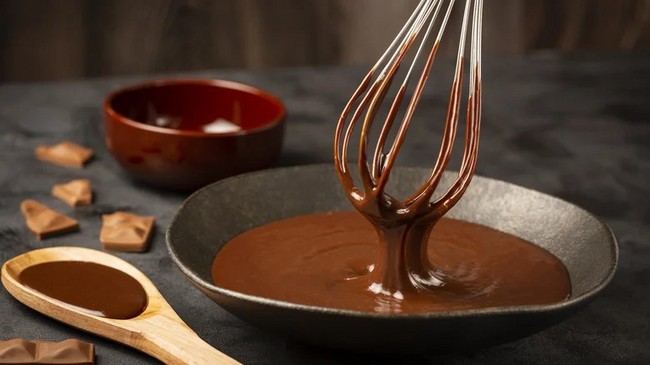
Ws Studio/Getty Images
Rich and delicious, chocolate ganache can make a perfect frosting for a cake, a dense filling for a tart, or the perfect truffles. It seems simple — it's just a couple of ingredients — but there are all kinds of ways it can go wrong. This can leave you with split, grainy ganache rather than the perfectly smooth stuff you've seen on baking shows and on Instagram reels.
But maybe you're not even there yet. Perhaps you're still wondering what the difference between ganache and regular frosting is. Well, frosting can take a range of forms, but chocolate buttercream combines cocoa powder, powdered sugar, and butter, while ganache is simply made from cream and chocolate. This makes it less sweet and more intense than regular frosting, especially if you use high-quality dark chocolate. And even though it seems like mixing two ingredients together is kindergarten-level baking, there's more potential for mishap than most people realize.
Whether you've had trouble with it in the past or you're making it for the first time and want to know where it could potentially go wrong, you've come to the right place. We're going to do a deep-dive into the common mistakes people make with chocolate ganache. From causing it to split to getting the consistency all wrong, these mistakes can lead to unusable ganache. But once you understand what they are, you can learn how to avoid them or, in some cases, fix them when things go awry.
Using large chunks of chocolate
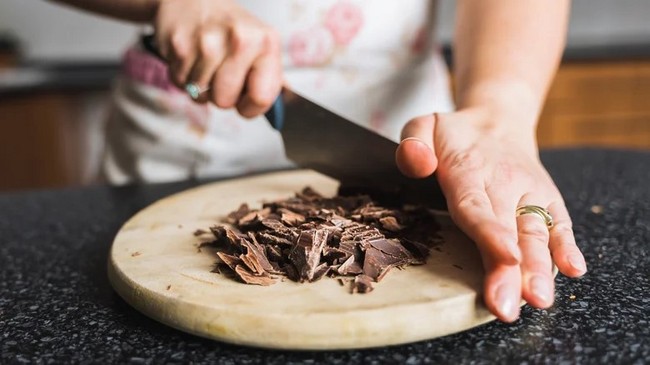
Patrik Molcan/Getty Images
While you can use chocolate chips or couverture chocolate chunks, bar chocolate is often the way to go for ganache. It's usually of better quality than chocolate chips and more readily accessible than couverture chocolate. Now, it can be tempting to just break the chocolate into squares and go from there, but this is a mistake. You should actually chop the chocolate as finely as you have the time and patience for.
The more finely you chop the chocolate, the easier it will melt into the cream. If the chunks are too large, you might find it hard to get them to melt into the cream fully. Then you're left in a position where you've got partially formed ganache and some chunk bits of chocolate. Also, try to chop the chocolate fairly evenly or some of it will melt much faster than other pieces. It doesn't have to be precise, but avoid having some large pieces and some fine shavings.
If you make a mistake and you're in the situation where your chocolate isn't melting, you can fix it. Place your bowl of ganache over a saucepan of lightly simmering water, making sure that the water isn't touching the bottom of the bowl. Then, stir until all the chocolate has melted. You don't want to use direct heat — such as putting the ganache in a saucepan on the stovetop — or you'll cause it to split or seize.
Using milk instead of cream
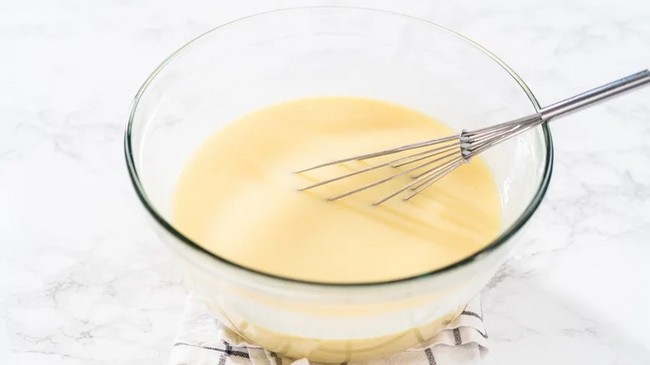
Arina P Habich/Shutterstock
Ganache is a simple substance. You just need two ingredients to make it: chocolate and heavy cream. If you're tempted to use milk or half-and-half in place of the cream, don't since it won't work the same.
It's easy to wrongly assume that if ganache works with cream, it will work with any liquid. Maybe you want to use milk because that's all you've got in the house and you don't want to make a trip to the store. Or perhaps you're trying to cut calories. But whatever your reason, you need that heavy cream to get the same results.
When you make it with a lower fat liquid, like milk, the chocolate will melt and you'll have something that resembles ganache, but it won't set in the same way. This isn't such a problem if you want a thin liquid ganache for pouring, but it won't set into something you can use for frosting, drip cakes, or truffles. You might be able to thicken it up by adding extra chocolate but the flavor will be off. It will also lack the richness of ganache made with cream. This isn't supposed to be a health food, so just head to the store and grab that heavy cream.
Using too much heat when melting the chocolate into the cream
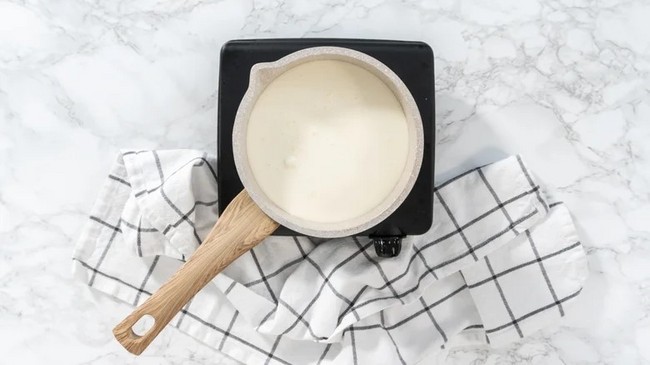
Arina P Habich/Shutterstock
The basic method for making ganache is melting chocolate and cream together. This might seem super basic, but it's easy to add too much heat. When you do this the chocolate can seize and the ganache can split. You end up with big lumps of chocolate that have overheated, won't melt, and have a greasy sheen of oil to the liquid parts of the mixture. In this instance, too much heat is the reason why your ganache's texture is off.
You might assume you can just put the cream and chocolate in a saucepan and melt them both on the stove, but this is likely to lead to split ganache. Instead, you should heat up the cream, then pour it over the chocolate to melt it. You should get the cream to the point where it's very hot and slightly steaming, but not boiling or simmering. It's fine if you see some small bubbles around the very edge of the pan but if the mixture is simmering or bubbling all over, it's too hot and you should wait for it to cool slightly before pouring it on your chocolate. As Mary Berry always says, "Chocolate melts in a child's pocket" — it really doesn't need that much heat to melt.
Failing to let the ingredients sit after pouring the cream over the chocolate

Candice Bell/Shutterstock
So, you've heated your cream and you've poured it over your chocolate. Now you should mix the two together, right? Well, actually, you should give it a beat before you do so. This way you won't over-stir the ingredients. After pouring the hot cream on the chocolate, just let it chill out for 2 to 3 minutes before you begin mixing them together. This gives the chocolate some time to melt so you don't need to stir it too much.
But why does this matter? For one thing, you probably have something better to do. Even checking your phone or staring out of the window for a couple of minutes is more fun than stirring chocolate that won't melt. The other issue is that stirring too much can lead to oily ganache. It can end up ruining the emulsion between the fats and the liquids, making it split.
But you can fix this split ganache if you run into problems. Extra liquid can help fix the emulsion, although it will dilute the mixture and make it more runny. This can be a problem if you're making truffles or you need it to set firm. You have options for adding more liquid — hot water, more cream, or even corn syrup can all fix split ganache.
Adding too little liquid
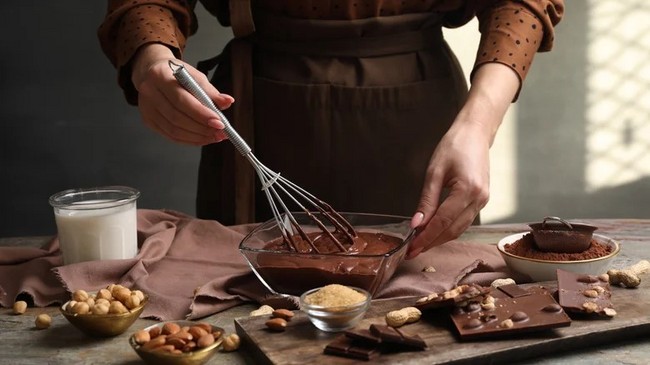
New Africa/Shutterstock
You might not think that adding too little cream could mess up your ganache. You'd rightly imagine that it would give it a thicker consistency, but not using enough liquid can actually cause ganache to split. That's not to say that you can't play with ratios. It's totally possible to use less cream and more chocolate to get a hard, rollable ganache. But be careful not to totally underdo it.
The problem comes from forming an emulsion. This is a mixture where fats are held in suspension in a liquid to make a cohesive substance. Ganache is an emulsion but can be a tricky one because there isn't anything to stabilize the emulsion (such as the egg yolk in mayonnaise). It also breaks much more easily.
When you use too little liquid, there's too much solid chocolate to melt in the amount of cream. This means there isn't enough liquid to hold the cocoa solids, milk proteins, and droplets of fat in suspension. It can also be a problem when you use a chocolate with a too-high cacao content. There isn't enough sugar to liquefy and hold the fats and solids in suspension so the ganache splits. That's why it's best not to exceed 70% cacao dark chocolate.
Not carefully whisking the chocolate and cream
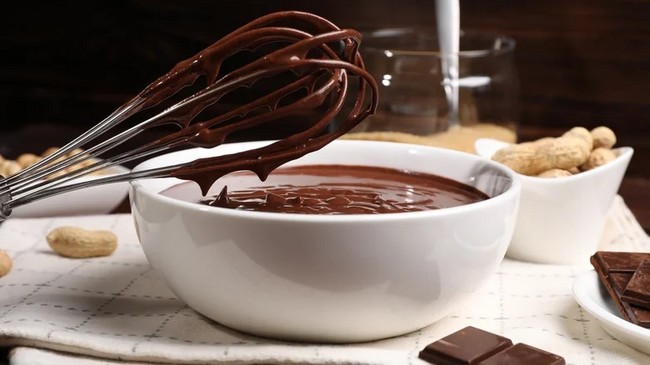
New Africa/Shutterstock
Whisking together the chocolate and cream too much, too quickly, or too vigorously can cause problems with the emulsion and cause ganache to split. This can lead to anything from a mild splitting that causes slight graininess to a dramatic split, with the chocolate seized into a lump and an oiliness covering any liquid parts.
But luckily, it's easy to avoid this by whisking the mixture gently. After pouring the cream over the chocolate and waiting a couple of minutes, it's time to whisk the mixture. Do so fairly softly, starting by making small circles in the center of the mixture and slowly working outwards into bigger circles, always whisking in one direction. This helps to create a stable emulsion and make a super silky ganache.
The melted chocolate will mix into the cream gradually. Once it looks shiny and there are no solid pieces of chocolate left, stop and leave it to set. Overmixing can be an issue, too, so don't overdo it.
Using the same ratios for all types of chocolate
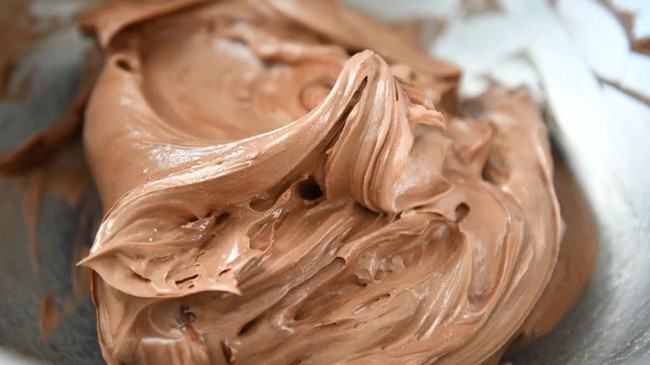
anniinatai/Shutterstock
If you've followed one chocolate ganache recipe and learned the ratio of cream to chocolate you need, you might assume that you know everything you need to know. But the key to ganache is finding the right ratio of cream to chocolate, and that varies depending on the type of chocolate you're using.
The classic ratio of one part cream to one part chocolate is what a lot of people think of when making ganache, but this is only true for dark chocolate. Other varieties need more chocolate and less cream to get the same results. Dark chocolate has a larger percentage of cocoa solids than milk or white chocolate. This means that it sets more solidly than other types. A ratio that would give you a spreadable ganache when using dark chocolate will give you a liquidy ganache that doesn't properly set if you try it with milk or white varieties.
Using the 1-to-1 ratio of cream to chocolate with dark chocolate gives you a ganache with a pudding-like consistency that you can use for fillings, frostings, or thick glazes. If you want the same consistency using milk chocolate, you need a 1-to-1.5 cream to chocolate ratio, and for white chocolate that ratio should be 1-to-2.
Trying to make truffles with a pouring ganache
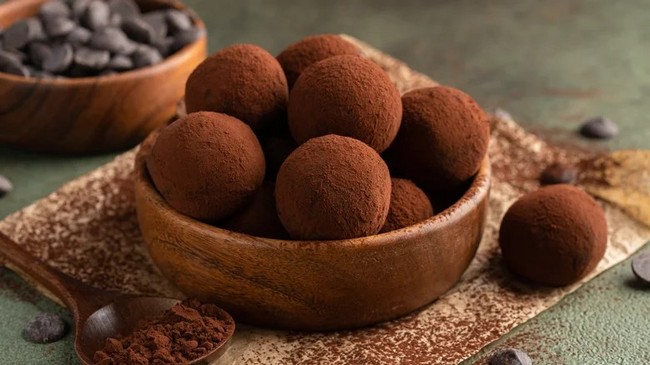
Alena_Kos/Shutterstock
You need to make chocolate ganache differently depending on what you use it for. The classic 1-to-1 ratio is fairly versatile, but you can't use it to make truffles, for instance, so it's important to think about what you want your ganache for before deciding on the ratio. We're going to be talking about the correct ratios when using dark chocolate, so you may need to look up a recipe for milk and white versions.
If you're trying to make a dark chocolate truffle recipe, you'll need a ratio of roughly 1-to-2 — one part cream to two parts chocolate. Some people increase this slightly to get truffles that set harder but you run the risk of it splitting, especially if the chocolate has a high percentage of cocoa solids. This 1-to-2 ratio is also good for stiff piping work.
A 1-to-1 ratio gives you ganache that's thick enough to spread on a cake or to use as a thick glaze if poured when it's not fully set. It can work as a ganache drip around the edge of a cake. You can also make thinner ganache with a ratio of 1.5-to-1 cream to chocolate. This makes a rich, intense hot chocolate, a thin glaze, a dipping sauce, or a sauce for ice cream.
Forgoing the option to add butter
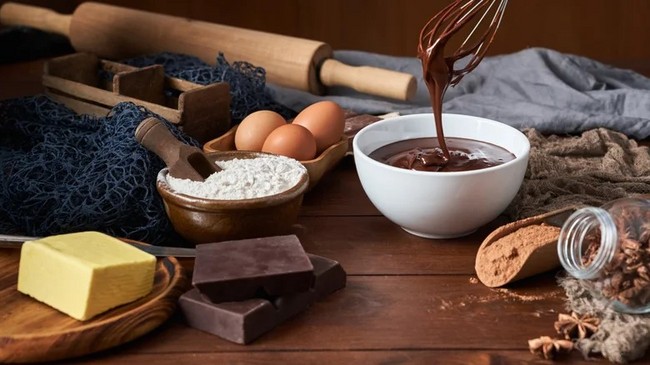
Apomares/Getty Images
While a basic recipe contains just cream and chocolate, butter is the ingredient that will majorly upgrade your chocolate ganache. It might seem like an unnecessary addition, but while you might not always want what butter brings to the bowl, it's a mistake not to at least consider it as an option. Many people don't even know about this potential ganache addition and that's a shame.
Butter adds an extra richness to ganache and an even creamier texture. It can also make it even shinier, which is a great option if you want a mirror glaze without the hassle or other potential problems of using gelatin. It can also help firm up the texture somewhat, which is great when you're using ganache as a frosting or filling. If you want to add butter, you mix it in after the chocolate and cream are combined. It's best to use room temperature or softened butter so it melts in more easily.
Not trying out dairy-free alternatives to cream

Tracy Morgan/Shutterstock
If you don't eat dairy or you're cooking for someone who doesn't, you might think that ganache is out of the picture. After all, it's basically 50% heavy cream. However, this isn't the case since there are various dairy-free alternatives to cream you can try.
Full fat coconut milk or coconut cream make particularly good alternatives to heavy cream. They're rich and thick with a creamy mouthfeel that comes from the saturated fat in coconuts. It also lends a delicious coconut flavor to the ganache. While this won't pair well with the flavors of every recipe, it can be even better than regular ganache for some. For instance, you could make a coconut cake with a layer of chocolate coconut milk ganache.
If you don't want a coconut milk texture, look for a commercial oat cream or soy cream. This will give you similar results to heavy cream, although it may not set quite as firmly, so you might need to experiment with the ratios to get the best results. It's also possible to make your own cashew cream to use in ganache, but it can be somewhat grainy if you don't have a Vitamix or similar high-speed blender.
Letting it set too much or not enough when attempting a ganache drip
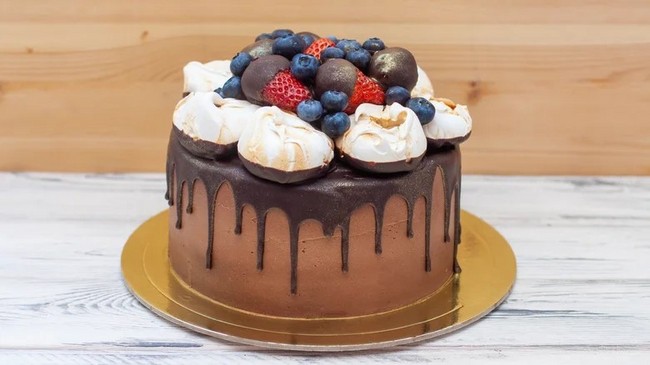
Larisa Sadomtseva/Shutterstock
You might have seen cakes with a chocolate ganache drip around the outside. It's a cake decorating technique that's perfect for beginners because it doesn't take too much practice to get it looking decent. However, it's certainly not foolproof. It's easy to either not let the ganache set enough or leave it to set for too long, both of which can cause problems.
If the ganache isn't set enough, it won't leave defined drips around the outside of the cake. It will just run straight down to the cake board or plate it's set on and pool there. But, once it sets too firm, you won't be able to coax it into drips at all. It will be spreadable rather than pourable.
You should use a cream to chocolate ratio of 1-to-1 for a ganache drip. Once it's fully mixed leave it to set until it's barely warm. It doesn't take all that long, maybe 15 to 30 minutes. You can check if it's ready by testing a little on the inside of the mixing bowl. Spoon some around the edge and see if it runs all the way back into the bowl or stops partway down the inside — the latter means it's ready to use. If it doesn't drip at all, it's set too much and you'll need to heat it a little over a pan of simmering water to loosen it.
Not trying out whipped ganache
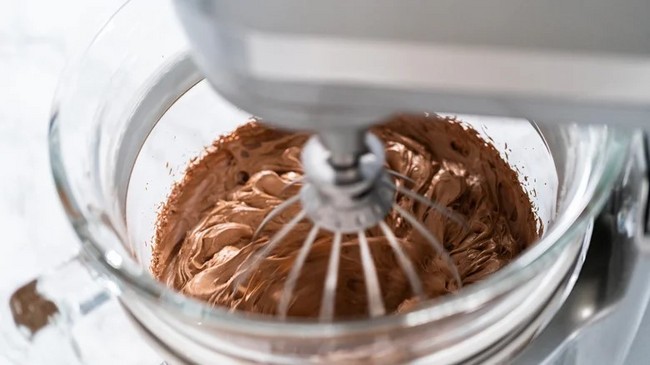
Arina P Habich/Shutterstock
Maybe you've made regular chocolate ganache a few times, but if you aren't trying out whipped ganache then you're missing out. This alternative version has a light, fluffy texture not dissimilar to mousse. You can use it as a frosting for cakes and cupcakes, as it has the benefit of piping better than regular ganache. It's also lighter and less intense as a filling for tarts and pies.
To start with, you make it the same as regular ganache, using the 1-to-1 ratio. However, instead of regular heavy cream, you need to use heavy whipping cream. Then, let it cool at room temperature until it has reached a spreadable consistency similar to peanut butter. Don't be tempted to speed things up by cooling it in the fridge. Finally, you beat it with an electric hand mixer or the whisk attachment on a stand mixer for around 3 minutes, stopping when it's light and fluffy.
Previous:McDonald's Filet-O-Fish: Is It Made With Real Fish?
Next:The Best Buffet Dessert Bars In The US
Hot key words
Hot Products
Popular Vendors